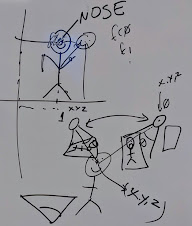This is an iPython Jupyter Notebook to let us look at some of the data we collected in class on 2022-09-26
Contents
This is an iPython Jupyter Notebook to let us look at some of the data we collected in class on 2022-09-26#
Import the python packages we’ll need#
print("install numpy")
!pip install numpy --quiet
print("install pandas")
!pip install pandas --quiet
print("install matplotlib")
!pip install matplotlib --quiet
install numpy
install pandas
install matplotlib
import pandas as pd
import matplotlib
import matplotlib.pyplot as plt
from pathlib import Path
import numpy as np
%matplotlib inline
Get the paths to the files and data we’ll need#
# # folders and stuff
# from tkinter import *
# from tkinter import filedialog
# root = Tk()
# root.withdraw()
# Open a tkinter file dialog to select the session id folder you want to analyze
session_folder_path = r"C:\Users\jonma\Dropbox\Northeastern\Courses\Biol2299\2022_09_Fall\com_vs_bos_data\FreeMocap_Data\sesh_2022-09-28_15_45_39"
session_folder_path = Path(session_folder_path)
print(session_folder_path)
data_arrays_path = session_folder_path / 'DataArrays'
print("The path to the data arrays is:", data_arrays_path)
C:\Users\jonma\Dropbox\Northeastern\Courses\Biol2299\2022_09_Fall\com_vs_bos_data\FreeMocap_Data\sesh_2022-09-28_15_45_39
The path to the data arrays is: C:\Users\jonma\Dropbox\Northeastern\Courses\Biol2299\2022_09_Fall\com_vs_bos_data\FreeMocap_Data\sesh_2022-09-28_15_45_39/DataArrays
#Specific file paths
com_xyz_npy_path = data_arrays_path / "totalBodyCOM_frame_XYZ.npy"
skeleton_body_dots_csv_path = data_arrays_path / "mediapipe_body_3d_xyz.csv"
# load the data in
com_xyz = np.load(com_xyz_npy_path)
skeleton_dataframe = pd.read_csv(skeleton_body_dots_csv_path)
---------------------------------------------------------------------------
FileNotFoundError Traceback (most recent call last)
Cell In[5], line 3
1 # load the data in
----> 3 com_xyz = np.load(com_xyz_npy_path)
4 skeleton_dataframe = pd.read_csv(skeleton_body_dots_csv_path)
File /opt/hostedtoolcache/Python/3.9.15/x64/lib/python3.9/site-packages/numpy/lib/npyio.py:405, in load(file, mmap_mode, allow_pickle, fix_imports, encoding, max_header_size)
403 own_fid = False
404 else:
--> 405 fid = stack.enter_context(open(os_fspath(file), "rb"))
406 own_fid = True
408 # Code to distinguish from NumPy binary files and pickles.
FileNotFoundError: [Errno 2] No such file or directory: 'C:\\Users\\jonma\\Dropbox\\Northeastern\\Courses\\Biol2299\\2022_09_Fall\\com_vs_bos_data\\FreeMocap_Data\\sesh_2022-09-28_15_45_39/DataArrays/totalBodyCOM_frame_XYZ.npy'
# Examples of how to access elements of the data array
nose_x = skeleton_dataframe["nose_x"]
nose_y = skeleton_dataframe["nose_y"]
nose_z = skeleton_dataframe["nose_z"]
print(f"nose_x.shape: {nose_x.shape}")
# This function plots a time series plot of a given body part
def plotXYZOverTime(column1, column2, column3, object, colors):
xdata = skeleton_dataframe[column1]
ydata = skeleton_dataframe[column2]
zdata = skeleton_dataframe[column3]
plt1 = plt.plot(xdata, color=colors[0])
plot2 = plt.plot(ydata, color=colors[1])
plot3 = plt.plot(zdata, color=colors[2])
plt.title("Position of " + object + " Over Time")
plt.xlabel("Frame Number")
plt.ylabel("Value")
plt.legend([object + " X", object + " Y", object+ "Z"])
plt.show()
# To change the color of the lines on the plot, change these three variables
colors = ["orange", "green", "blue"]
# produces a simple plot of `com_xyz` time series of nose
plotXYZOverTime("nose_x", "nose_y", "nose_z", "Nose", colors)
right_toe_x = skeleton_dataframe["right_foot_index_x"]
right_toe_y = skeleton_dataframe["right_foot_index_y"]
right_toe_z = skeleton_dataframe["right_foot_index_z"]
right_heel_x = skeleton_dataframe["right_heel_x"]
right_heel_y = skeleton_dataframe["right_heel_y"]
right_heel_z = skeleton_dataframe["right_heel_z"]
cx = com_xyz[np.arange(2500,3500),0]
cy = com_xyz[np.arange(2500,3500),1]
#Change the frame numbers for an area of interest
startFrame = 2500
endFrame = 3500
fig2 = plt.Figure()
plt.plot(right_toe_x[startFrame:endFrame], right_toe_y[startFrame:endFrame], 'r')
plt.plot(right_heel_x[startFrame:endFrame], right_heel_y[startFrame:endFrame], 'b')
plt.plot(cx, cy, 'g')
plt.title("Foot Position vs. Center of Mass While Standing on One Foot")
plt.xlabel("X Position")
plt.ylabel("Y Position")
plt.legend(["Right Toe", "Right Heel", "Center Of Mass"])
plt.show()
#This function creates two subplots with the first showing location of foot vs cetner of mass while holding a weight, second without holding weight
def plotWithandWithoutWeight(startFrameNoWeight, endFrameNoWeight, startFrameWithWeight, endFrameWithWeight, onefoot=True, foot="right"):
#extract the data from the data frame
right_toe_x = skeleton_dataframe["right_foot_index_x"]
right_toe_y = skeleton_dataframe["right_foot_index_y"]
right_toe_z = skeleton_dataframe["right_foot_index_z"]
right_heel_x = skeleton_dataframe["right_heel_x"]
right_heel_y = skeleton_dataframe["right_heel_y"]
right_heel_z = skeleton_dataframe["right_heel_z"]
left_toe_x = skeleton_dataframe["left_foot_index_x"]
left_toe_y = skeleton_dataframe["left_foot_index_y"]
left_toe_z = skeleton_dataframe["left_foot_index_z"]
left_heel_x = skeleton_dataframe["left_heel_x"]
left_heel_y = skeleton_dataframe["left_heel_y"]
left_heel_z = skeleton_dataframe["left_heel_z"]
cxWeight = com_xyz[np.arange(startFrameWithWeight,endFrameWithWeight),0]
cyWeight = com_xyz[np.arange(startFrameWithWeight,endFrameWithWeight),1]
cxNoWeight = com_xyz[np.arange(startFrameNoWeight,endFrameNoWeight),0]
cyNoWeight = com_xyz[np.arange(startFrameNoWeight,endFrameNoWeight),1]
#Create the plots
fig, (ax1, ax2) = plt.subplots(nrows=1, ncols=2, constrained_layout=True)
fig.suptitle('Foot Postition vs. Center of Mass', fontsize=16)
if (onefoot==False or (onefoot and foot=="right")):
ax2.plot(right_toe_x[startFrameWithWeight:endFrameWithWeight], right_toe_y[startFrameWithWeight:endFrameWithWeight], 'r')
ax2.plot(right_heel_x[startFrameWithWeight:endFrameWithWeight], right_heel_y[startFrameWithWeight:endFrameWithWeight], 'b')
ax1.plot(right_toe_x[startFrameNoWeight:endFrameNoWeight], right_toe_y[startFrameNoWeight:endFrameNoWeight], 'r')
ax1.plot(right_heel_x[startFrameNoWeight:endFrameNoWeight], right_heel_y[startFrameNoWeight:endFrameNoWeight], 'b')
if (onefoot==False or (onefoot and foot=="left")):
ax2.plot(left_toe_x[startFrameWithWeight:endFrameWithWeight], left_toe_y[startFrameWithWeight:endFrameWithWeight], 'orange')
ax2.plot(left_heel_x[startFrameWithWeight:endFrameWithWeight], left_heel_y[startFrameWithWeight:endFrameWithWeight], 'purple')
ax1.plot(left_toe_x[startFrameNoWeight:endFrameNoWeight], left_toe_y[startFrameNoWeight:endFrameNoWeight], 'orange')
ax1.plot(left_heel_x[startFrameNoWeight:endFrameNoWeight], left_heel_y[startFrameNoWeight:endFrameNoWeight], 'purple')
ax1.plot(cxNoWeight, cyNoWeight, 'g')
ax2.plot(cxWeight, cyWeight, 'g')
ax2.set_title('With Weight', fontsize=14)
ax1.set_title("Without Weight", fontsize=14)
ax1.set_xlabel(xlabel='X Position', fontsize=12)
ax1.set_ylabel('Y Position', fontsize=12)
ax2.set_xlabel("X Position", fontsize=12)
ax1.set_aspect("equal")
ax2.set_aspect("equal")
if(onefoot):
plt.legend(["Toe", "Heel", "Center Of Mass"])
else:
plt.legend(["Left Toe", "Left Heel", "Right Toe", "Right Heel", "Center Of Mass"])
plt.show()
# Change these to the desired frame numbers for when participants are standing on right foot with/without weight
startFrameWithWeight = 2500
endFrameWithWeight = 3500
startFrameNoWeight = 2500
endFrameNoWeight = 3500
# Plot weight vs no weight right foot
plotWithandWithoutWeight(startFrameNoWeight, endFrameNoWeight, startFrameWithWeight, endFrameWithWeight, onefoot=True, foot="right")
# Change these to the desired frame numbers for when participants are standing on left foot with/without weight
startFrameWithWeight = 2500
endFrameWithWeight = 3500
startFrameNoWeight = 2500
endFrameNoWeight = 3500
#Plot weight vs no weight left foot
plotWithandWithoutWeight(startFrameNoWeight, endFrameNoWeight, startFrameWithWeight, endFrameWithWeight, onefoot=True, foot="left")
# Change these to the desired frame numbers for when participants are standing on both feet with/without weight
startFrameWithWeight = 2500
endFrameWithWeight = 3500
startFrameNoWeight = 2500
endFrameNoWeight = 3500
#Plot weight vs no weight both
plotWithandWithoutWeight(startFrameNoWeight, endFrameNoWeight, startFrameWithWeight, endFrameWithWeight, onefoot=False)
#This function creates two subplots with the first showing location of foot vs cetner of mass while holding a weight, second without holding weight
def plotOneVsTwoFeet(startFrameOneFoot, endFrameOneFoot, startFrameTwoFeet, endFrameTwoFeet, colors, weight=False):
#extract the data from the data frame
right_toe_x = skeleton_dataframe["right_foot_index_x"]
right_toe_y = skeleton_dataframe["right_foot_index_y"]
right_toe_z = skeleton_dataframe["right_foot_index_z"]
right_heel_x = skeleton_dataframe["right_heel_x"]
right_heel_y = skeleton_dataframe["right_heel_y"]
right_heel_z = skeleton_dataframe["right_heel_z"]
left_toe_x = skeleton_dataframe["left_foot_index_x"]
left_toe_y = skeleton_dataframe["left_foot_index_y"]
left_toe_z = skeleton_dataframe["left_foot_index_z"]
left_heel_x = skeleton_dataframe["left_heel_x"]
left_heel_y = skeleton_dataframe["left_heel_y"]
left_heel_z = skeleton_dataframe["left_heel_z"]
cxTwoFeet = com_xyz[np.arange(startFrameOneFoot,endFrameOneFoot),0]
cyTwoFeet = com_xyz[np.arange(startFrameOneFoot,endFrameOneFoot),1]
cxOneFoot = com_xyz[np.arange(startFrameTwoFeet,endFrameTwoFeet),0]
cyOneFoot = com_xyz[np.arange(startFrameTwoFeet,endFrameTwoFeet),1]
#Create the plots
fig, (ax1, ax2) = plt.subplots(nrows=1, ncols=2, constrained_layout=True)
fig.suptitle('Foot Position vs. Center of Mass', fontsize=16)
#Plot one foot
ax1.plot(right_toe_x[startFrameOneFoot:endFrameOneFoot], right_toe_y[startFrameOneFoot:endFrameOneFoot], colors[1])
ax1.plot(right_heel_x[startFrameOneFoot:endFrameOneFoot], right_heel_y[startFrameOneFoot:endFrameOneFoot], colors[2])
ax1.plot(cxOneFoot, cyOneFoot, colors[0])
#Plot both feet
ax2.plot(left_toe_x[startFrameTwoFeet:endFrameTwoFeet], left_toe_y[startFrameTwoFeet:endFrameTwoFeet], colors[1])
ax2.plot(left_heel_x[startFrameTwoFeet:endFrameTwoFeet], left_heel_y[startFrameTwoFeet:endFrameTwoFeet], colors[2])
ax2.plot(cxTwoFeet, cyTwoFeet, colors[0])
ax2.plot(right_toe_x[startFrameTwoFeet:endFrameTwoFeet], right_toe_y[startFrameTwoFeet:endFrameTwoFeet], colors[1])
ax2.plot(right_heel_x[startFrameTwoFeet:endFrameTwoFeet], right_heel_y[startFrameTwoFeet:endFrameTwoFeet], colors[2])
ax2.set_title('Both Feet', fontsize=14)
ax1.set_title("One Foot", fontsize=14)
ax1.set_xlabel(xlabel='X Position', fontsize=12)
ax1.set_ylabel('Y Position', fontsize=12)
ax2.set_xlabel("X Position", fontsize=12)
plt.legend(["Toe", "Heel", "Center Of Mass"])
plt.show()
# Plots one vs two feet (can also use this to plot one vs two feet while holding a weight, just change the start frames accordingly)
startFrameOneFoot = 0
endFrameOneFoot = 1000
startFrameTwoFeet = 0
endFrameTwoFeet= 1000
#Change colors if desired
colors= ["red", "orange", "blue"]
plotOneVsTwoFeet(startFrameOneFoot, endFrameOneFoot, startFrameTwoFeet, endFrameTwoFeet, colors)


